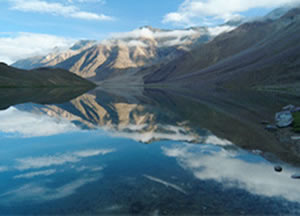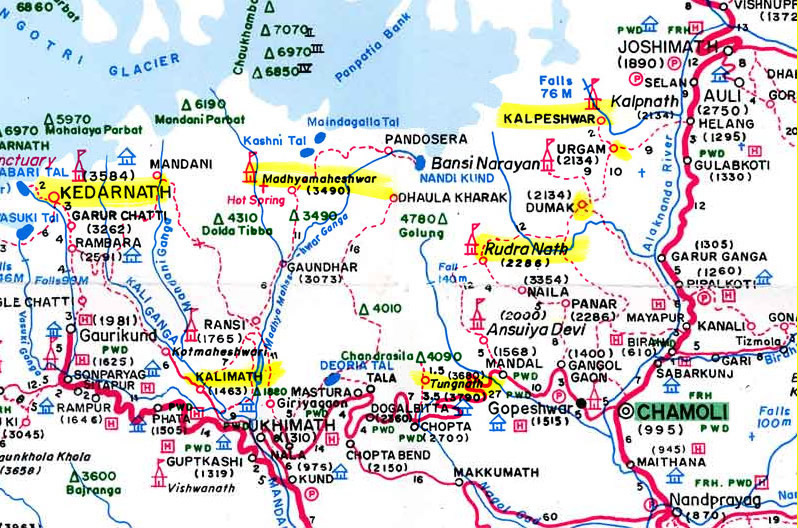Panch Kedars
Mythology

- Pandavas with dog Dharma

The Mahabharata is one of the oldest epics in the world and was written by the sage Vyasa. There is no subject on which it doesn’t deal with.However all the various subjects are woven into the story of the Kuru dynasty which ruled over India about five thousand years ago. Modern Delhi is built over their capital city of Indraprastha. The epic deals with the rivalry between the cousins known collectively as the Pandavas and the Kauravas. It ends in the internecine war between the two factions. The Pandavas were five in number and are said to be the sons of the gods in as much as they were all extremely noble. Arjuna, the hero of the epic and the middle one amongst the Pandavas is the one to whom Lord Krishna gave the discourse of the Srimad Bhagavad Gita. This discourse comes in the middle portion of the Mahabharata and deals with the human problem – how to attain liberation from the coils of material life. However it also deals with the very practical aspect of how to deal with our day-to-day life.
At the end of their life, the Pandavas decided to give up their kingdom and go to the Himalayas and meditate on their favourite deity, Lord Shiva. So they set out accompanied by their wife, Draupadi. When they reached the place called Rudraprayag, they thought they had a glimpse of Lord Shiva. They tried to chase him but he took on the form of a buffalo and dashed off towards the north. They followed in hot pursuit and eventually caught up with him at the place that is now known as Kedarnath. The Lord now dived into the earth. Only the hind portion of the buffalo was sticking out. This was caught by one of the brothers called, Bhima. But pull as he might, he couldn’t get the rest of the buffalo out of the ground. The hump now turned into a Shiva Lingam and remained at this place. Each of the other parts appeared at four other places and came to be collectively known as the Panch Kedars or the five Kedars. All these lie in the Garwal Himalayas in the modern state known as Uttranchal.
These five temples are sprawled all over the vast Kedar valley at altitudes ranging from 1500 m. to 3680 m.The five temples lie ensconced in the region of the Upper Himalayas with the high snow covered hill ranges of the Nanda Devi, Chaukhamba, Kedarnath and Neelkanth peaks forming their back drop.
Kedarnath is located in the Mandakini River valley while the other shrines are situated in the highlands between the Mandakini valley and the Alakananda gorge. They are so remotely located that except kalpeshwar, the other four are still not accessible by motorable roads but reached by strenuous trekking, starting from late April or early May till early October. For the rest of year (the winter season), the shrines are closed due to heavy snowfall. Kalpheshwar is accessible through out the year by a short trek of about 3 km (2 mi) from the nearest road head. (Scroll below for schematic maps of the rough locations of Panch Kedar).
The village of Kedarnath is on the edge of Kedarnath mountain slope in a remote northern part of the Garhwal Himalayas. Kedarnath ranges drain into the Mandakini River that emerges from the steady edge of the Churabre glacier and forms the picturesque Mandakini valley. The Dudhganga, Madhuganga, Swargaduari and Saraswathi are the streams that flow in the valley behind the Kedarnath temple. Also seen close to the temple are four sacred ponds called Retah, Udak, Rudra and Rishi. Tunganath has an impressive backdrop of the peaks of Panchulli, Nanda Devi, Dunagiri, Kedarnath and Bandar Poonch. The Vaitarani stream flows near Rudranath. Kalpeshwar is located in the Urgam valley in a dense forest area. Urgam Valley has apple orchards, terraced fields where potato is grown extensively. Kalp Ganga river, a tributary of the Alaknanda, flows through the valley.
The Five Kedars
-
Please click on the name to know details.
- Tunganath: 3,810 m
- Kedarnath: 3584 m
- Madmaheswar: 3289 m
- Rudranath: 2286 m.
- Kalpeshwar: 2134 m.
Panch Kedar Map
Below is a rough map of Panch Kedars. Thick Lines show roads and dotted lines are trekking paths. Temples are highlighted. Except Rudranath temple all other are not easily accessible and require arduous treks.Click on the temple name to know more about the temple..

ACCOMMODATION
- Dharamshalas, Ashrams, Cottages and Tourist Rest House offer a comfortable stay
